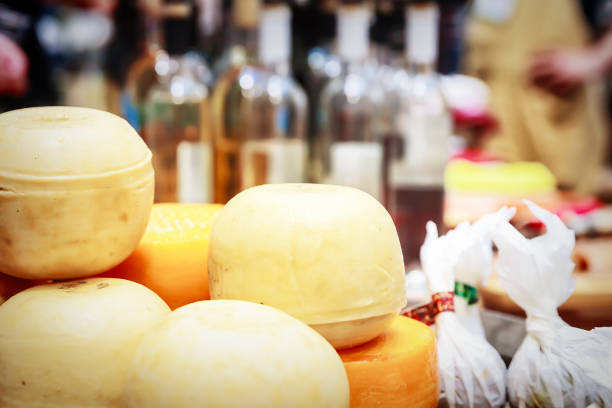When it comes to French cheeses, classics like Brie, Camembert, and Roquefort often steal the spotlight. However, France boasts an extensive and diverse array of cheeses that go beyond these renowned varieties. In this article, we delve into the lesser-known French cheeses, uncovering their unique flavors, textures, and regional origins. From creamy soft cheeses to pungent blues and nutty hard cheeses, there is a world of undiscovered treasures waiting to be explored.
1. Tomme de Savoie: Hailing from the Savoie region, Tomme de Savoie is a semi-hard cheese made from cow's milk. It has a natural rind and a smooth, creamy texture with a delicate nutty flavor. This cheese pairs well with cured meats and is often enjoyed with a glass of local Savoie wine.
2. Banon: Originating from the Provence-Alpes-Côte d'Azur region, Banon is a small, soft cheese made from goat's milk. It is wrapped in chestnut leaves, which impart a distinct earthy flavor. Banon has a rich and creamy texture, and its flavors intensify as it ages. It is typically enjoyed spread on crusty bread or served alongside fresh fruits.
3. Fourme d'Ambert: Hailing from the Auvergne region, Fourme d'Ambert is a blue cheese made from cow's milk. It has a creamy and crumbly texture with a subtle tangy flavor. The blue veins running through the cheese offer a delightful contrast. Fourme d'Ambert pairs well with sweet fruits like pears and is a perfect addition to salads or cheese platters.
4. Valençay: This pyramid-shaped cheese comes from the Loire Valley. Made from goat's milk, Valençay has a bloomy rind with a creamy, dense interior. It offers a combination of mild, tangy flavors with hints of citrus. Traditionally, the top of the cheese is truncated, which legend says is because Napoleon Bonaparte sliced it off in a fit of rage. Valençay pairs well with crusty bread and crisp white wines.
5. Comté: One of the most popular French cheeses, Comté is a semi-hard cheese produced in the Jura Mountains. Made from unpasteurized cow's milk, it has a complex, nutty flavor with notes of caramel and fruit. Comté is aged for varying lengths of time, resulting in different flavor profiles. It is a versatile cheese, suitable for snacking, cooking, or melting into dishes.
6. Ossau-Iraty: Hailing from the Pyrenees region, Ossau-Iraty is a cheese made from sheep's milk. It has a firm and slightly crumbly texture with a nutty and buttery flavor. This cheese pairs beautifully with charcuterie, dried fruits, and robust red wines.
7. Mimolette: Originating from the northern region of France, Mimolette is a hard cheese with a distinct orange hue. It has a firm, crumbly texture and a nutty, caramel-like flavor. Mimolette is often grated and used as a topping for dishes or enjoyed on its own with a glass of beer.
8. Bleu d'Auvergne: Another notable blue cheese from the Auvergne region, Bleu d'Auvergne is made from cow's milk. It has a creamy and crumbly texture with a strong, tangy flavor and distinct blue veins. This cheese adds depth and complexity to salads, sauces, and savory dishes.
9. Rigotte de Condrieu: This small, creamy cheese comes from the Rhône-Alpes region
. Made from goat's milk, Rigotte de Condrieu has a delicate and slightly acidic flavor with a smooth, velvety texture. It is often enjoyed as a standalone cheese or incorporated into salads and pastas.
10. Pélardon: Hailing from the Languedoc-Roussillon region, Pélardon is a small, tangy goat cheese with a wrinkled rind. It has a creamy and slightly crumbly texture with a distinctive, robust flavor. Pélardon is typically enjoyed with fresh bread, olives, and a glass of regional wine.
11. Bleu des Causses: This blue cheese comes from the Causses region in southern France. Made from cow's milk, it has a crumbly texture with a balanced and mellow flavor. Bleu des Causses pairs well with crusty bread, fresh fruits, and sweet wines.
12. Pouligny-Saint-Pierre: Originating from the central region of France, Pouligny-Saint-Pierre is a pyramid-shaped goat cheese with a creamy and crumbly texture. It has a delicate, slightly acidic flavor with nutty undertones. This cheese is often enjoyed on its own or with a drizzle of honey.
13. Reblochon: Reblochon is a soft and creamy cheese from the Haute-Savoie region. Made from raw cow's milk, it has a distinctive aroma and a rich, buttery flavor. Reblochon is a key ingredient in the famous French dish Tartiflette, and it melts beautifully when heated.
14. Picodon: Hailing from the Rhône-Alpes and Provence regions, Picodon is a small goat cheese with a wrinkled rind. It has a strong and tangy flavor with a slightly crumbly texture. Picodon is often enjoyed with bread, paired with dried fruits or honey.
15. Saint-Nectaire: Saint-Nectaire is a semi-soft cheese from the Auvergne region. Made from cow's milk, it has a creamy and supple texture with a subtle, earthy flavor. Saint-Nectaire is a versatile cheese that can be enjoyed on a cheese board, melted in dishes, or used in sandwiches.
16. Beaufort: Beaufort is a firm and fruity cheese from the Alps. Made from raw cow's milk, it has a smooth and creamy texture with a complex, nutty flavor. Beaufort is commonly used in traditional Alpine dishes like fondue and gratins.
17. Chaource: Chaource is a soft and creamy cheese from the Champagne region. Made from cow's milk, it has a bloomy rind and a rich, buttery flavor with a hint of tanginess. Chaource is often enjoyed with Champagne or paired with fresh fruits and nuts.
18. Cantal: Cantal is one of the oldest cheeses in France, originating from the Auvergne region. It is a semi-hard cheese with a firm texture and a slightly tangy, buttery flavor. Cantal is versatile and can be grated, melted, or enjoyed on its own.
19. Persillé de Tignes: This blue cheese comes from the Tignes region in the French Alps. Made from cow's milk, it has a dense and crumbly texture with a strong, salty flavor. Persillé de Tignes is often used in sauces, dressings, and as a topping for grilled meats.
20. Maroilles: Maroilles is a pungent, washed-rind cheese from northern France. Made from cow's milk, it has a creamy and soft texture with a robust, earthy flavor. Maroilles is a beloved ingredient in traditional dishes like tarte au Maroilles and carbonade flamande.
These lesser-known French cheeses offer a delightful exploration for cheese enthusiasts, allowing them to savor the diverse flavors, textures, and aromas that French cheesemaking has to offer. From mild and creamy to bold and pungent, there is a French cheese for every palate and occasion. So, go ahead and embark on a delicious journey of discovery, and let these hidden gems expand your appreciation for the artistry of French cheese.
While classics like Brie and Camembert rightly deserve their acclaim, exploring the lesser-known French cheeses can be a delightful and rewarding culinary adventure. From the creamy Tomme de Savoie to the tangy Pélardon, these cheeses showcase the rich diversity and craftsmanship of French cheesemaking. So, step beyond the familiar and embark on a journey to discover the hidden gems of French cheese, indulging in their unique flavors and experiencing the true essence of French terroir.




